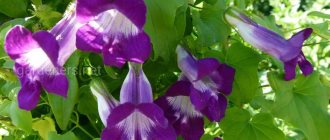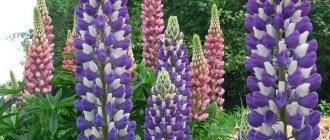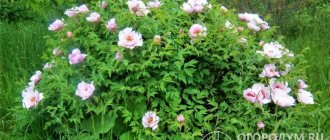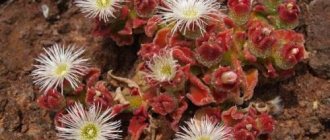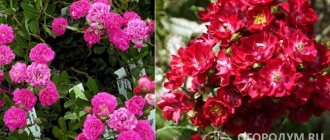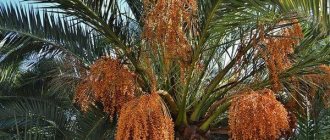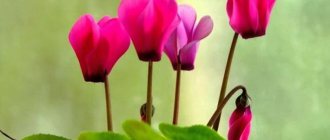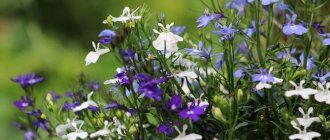This spectacular ornamental plant began to delight amateur gardeners not so long ago. Dichondra was first presented at the Flowers 2004 exhibition. There, the plant won the hearts of spectators and judges, receiving second place. The name can be translated from Greek as “a pair of grains.” This is the name given to the flower because of the appearance of the fruit.
Dichondra is represented by ten species. Belongs to the Bindweed family. In the wild it is found in the tropics and subtropics. Prefers moist forests and swampy areas of East Asia, Australia, and America.
Dichondra in the garden
Features of care
This plant grows well in city apartments. But it can just as successfully be grown in open ground, thereby decorating your garden plot. Bindweed is unpretentious and undemanding to care. It grows quickly and practically does not get sick, which is why it is loved by many flower growers and landscape designers. The owner is required to regularly water, spray and determine the correct planting location or position of the flower container.
Temperature
Dichondra ampel prefers temperatures of 18-25 ℃ above zero. But it is quite capable of surviving and growing in colder or hotter conditions.
Important! Thermometer readings below +10 ℃ have a detrimental effect on the flower, as do large temperature changes.
Registration of site boundaries
Lighting
This representative of Convolvulaceae is not capricious in terms of illumination. It grows equally well in the shade and in the sun. But still, if the primary goal is a decorative function, then growing Silver Falls dichondra is in a sunnier area. Under the influence of sunlight, the vine becomes stronger, more branched, and the color of the leaves acquires richness and depth. This applies to a greater extent to varieties with silver leaves. Since this shade can only be preserved in plants planted on the sunny side of the site.
Watering
The plant tolerates short droughts calmly, but gratefully accepts regular watering, delighting the owner with a lush crown and large leaves. Watering is optimal before sunset. This will help avoid possible burns to the surface of the sheet. In hot summer conditions, watering should be done every day. If the temperature does not rise above +20 ℃, then watering is permissible after a day or two. The dichondra flower does not like cold water. The flower may die from hypothermia of the root system.
Spraying
In case of hot weather, the plant requires leaf spraying. Just like watering, the procedure should be carried out in the evening to avoid burns to the bush.
A sufficient supply of moisture to the plant ensures its decorative effect.
Humidity
Despite the fact that dichondra creeping tolerates drought well, it loves good, moist soil and air. If in the area where the bush grows, the water is located close to the surface, then the plant will provide itself with adequate moisture, although watering in this case is also necessary, but less often - once every seven days. When groundwater is located far from the root system, watering must be carried out with special care, otherwise the leaf will become smaller.
Priming
Dichondra loves loamy soils. It is better if they are drainage and balanced in terms of acid-base indicators. The plant does not do well in acidic soil.
Feeding
Responsive to the application of fertilizers. The first feeding should be after the first leaf appears. The time for the next one will come a couple of days before transplantation to a permanent place. After that, potassium and nitrogen compounds are added every two to three weeks. If you follow some simple rules, the plant will be lush and fast-growing.
Pot
When growing dichondra at home in a pot, it should be noted that the plant requires sufficient volume for full growth. In a small container the decorative effect will not be fully noticeable.
A well-chosen pot is of great importance for the plant.
Application
- Dichondra is used as a decorative foliage design for gardens or flower beds using pots or hanging baskets.
- Dichondra is grown where other grass does not grow well. The plant looks good in stone gardens, between the tiles of alleys, under trees.
- Sometimes a silver waterfall is used to create an imitation of water running between stones or to imitate a lake covered in ripples.
- You can weave a fence with creeping stems, but you need to remember that a lawn that consists of only dichondra is very difficult to grow and maintain in a well-groomed form.
- The liana combines with petunias, dahlias, all kinds of asters, and also looks great next to conifers and roses.
Features of winter care. Winter hardiness
Dichondra Flower Silver Waterfall or Silver Threads
Wintering of bindweed must be ensured indoors. If the climate is mild and severe frosts are not expected, then it is enough to just cover the plant during the cold period. The room does not have to be warm, just the absence of sub-zero temperatures is enough.
Note! If dichondra grew in open ground, then the stems should first be trimmed. Thus, only the root is brought into the house along with a lump of earth.
Coolness and darkness plunge the bindweed into hibernation. With the onset of spring, children can be found on the roots; they should be carefully separated from the adult plant and planted on the site. During the winter, the plant does not need to be fed, and can be watered once every two weeks.
Growing conditions - soil, planting site
Dichondra is not difficult to grow. Due to its origin, it makes very specific requirements. The silver and creeping species have the same growing requirements. Both species grow best in the sun; they can be grown in partial shade.
Soil for dichondra is needed with the following characteristics:
- fertile;
- must be permeable (sand can be added to the flower soil);
- moderately humid.
The most important condition is soil permeability. The plant does not like it when there is excess water at the roots; the pot must have drainage made of expanded clay and pebbles.
Transfer
Bacopa ampelous - growing and care at home
You need to replant the plant to a permanent place in the evening. During the night, the root system adapts to new conditions, which will increase the survival rate of the bush.
Before planting, you need to form holes at a distance of 10 cm from each other. A peat mixture is placed at the bottom of each hole. And only after this, with care, so as not to damage the delicate roots, is the bush planted. The hole is filled with earth and watered well with warm, settled water.
Planting dichondra seedlings
general information
The evergreen perennial is a close relative of morning glory and other bindweeds. Its long, tenacious shoots grow up to 1.5 m and form a continuous carpet on any surface. In addition, dichondra also blooms in summer.
The root system matches the above-ground part - superficial and creeping. Dichondra quickly grows in breadth because its shoots self-root during growth. The small leaves resemble coins with a diameter of 0.5 to 2.5 cm.
Photo: sad6sotok.ru
Features of outdoor care
Ampelous pelargonium or geranium - growing and care at home
Dichondra ampel planting and care, cultivation - practically does not cause problems. Special attention should be paid to preventive measures. For example, to avoid the appearance of insects on bushes you need to:
- limit watering in sufficiently moist soil, cool climates, and densely planted areas;
- eliminate mulching;
- use only hand weeding, as it can damage the nearby root system;
- plant plants on nitrogen-poor lands.
How does it reproduce
Dichondra is grown not only from seeds, although this method is very popular among gardeners. In addition, the plant can be propagated by cuttings or by rooting layering.
Dichondra ampelous growing from seeds
The seeds of the plant are sown in the ground in early February. Before planting, the material should be soaked for a day in water or in a solution of a growth stimulator, which will quickly awaken and start all the necessary processes in a small seed. The seeds are placed in a mixture of soil and peat to a depth of half a centimeter. It is more convenient to use small pots, planting 2-3 seeds. Then the container is closed with film or glass.
Additional Information! Don't forget about container ventilation. By providing good lighting and an air temperature of about +23 ℃, you can grow a strong plant.
Often dichondra ampelous is grown from seeds not in pots, but in special peat tablets. This solution has also proven itself well and is often a more convenient way to plant dichondra seeds. Such tablets already contain the required amount of nutrients, which provides plants with greater germination. In addition, further transplantation of grown dichondra seedlings into the ground is less traumatic for its root system.
Only one seed is placed in one tablet. But no matter how dichondra is planted and cared for, seedlings will appear in 7-8 days. The growth of seedlings is very slow. The film and glass can be removed when the seedling grows a little.
Planting dichondra in separate containers
The soil under the shelter should be regularly ventilated, loosened and watered. The young plant does not tolerate direct sunlight, nor does it tolerate darkness. After the fourth leaf appears on the young plant, it is time to pick. If a plant has a place in a hanging pot, then it is advisable to immediately transplant it to a permanent place. When the plant grows in the garden, the sprout is temporarily transplanted into a large container. Planted in open ground only if the weather is warm.
Planting and caring for dichondra in open ground requires regular manipulations and a beautiful bush will delight the owner throughout the growing season.
Important! Planting on a site in the middle zone is carried out two months after planting the seeds. Often the time for planting a grown shoot shifts to mid-June, as, for example, in Siberia.
Dichondra: propagation by cuttings
In the process of pruning the vines, cuttings remain. This is an excellent planting material. By placing them in water and waiting for the roots to appear, you can plant the cuttings. First they are placed in containers under film. During this period, the plant needs sufficient lighting, air temperature 20-25 ℃ above zero, regular watering and ventilation.
After a short time, the cut stem will take root and grow. After this, it is planted in a permanent place.
Reproduction of dichondra by layering
This method is the simplest and does not require any special skills from the grower. To propagate a plant by layering, you need to bend the stem to the surface of the ground and secure it in this position, watering regularly. After a root system appears at the point of contact with the ground, the daughter plant is cut off from the mother plant.
Why is it recommended to plant the plant by seeds?
This plant can be propagated vegetatively, but experts most often resort to growing dichondra from seeds. Finding cuttings and layering is quite problematic, but seeds are sold in most flower shops.
Another advantage of the seed method is that the rooting process occurs much faster than with vegetative propagation.
Possible problems
Dichondra is undemanding to care . An unpretentious plant copes well with difficulties. It is recommended to regularly spray the stems with special compounds throughout the growing season. This manipulation is justified in relation to pest control. Fleas and nematodes can cause significant damage to the bush, and fighting them will require more effort and time than prevention.
Worth knowing! Adding fluff lime to the soil has worked well. For the same purpose, before planting in the garden, plants are sprayed with a solution of copper sulfate.
Common varieties
Two of the available ten varieties are common in Russia.
Emerald Falls
The Dichondra variety Emerald Falls is distinguished by the fact that it needs significantly more moisture for proper cultivation. The leaves of the plant are colored rich green. Feels great in partial shade, while the lack of light has virtually no effect on the color of the leaves. As a rule, this type is chosen when there is good soil cover. At the same time, dichondra ampelous Emerald Falls also looks impressive in hanging flowerpots, thereby justifying its name.
Emerald waterfall in a composition with flowering plants
Silver Falls
This species has leaves with a beautiful silver tint. The stems of Dichondra Silver Falls are long and the plant needs sunlight to produce its silvery color. It is drought resistant. Resistant to pests and adverse atmospheric conditions.
As a rule, Dichondra silvery waterfall is grown in containers and flowerpots. Hanging silvery branches look unusual and are a decoration for any garden design.
Dichondra silvery waterfall growing in a container
Pest and disease control
By its nature, dichondra is an ordinary weed, so it is not affected by pests and diseases. The only parasite that poses a serious threat is nematodes, which are difficult to notice and useless to fight. If the problem has already been discovered, such plants need to be removed quickly, the soil should be disinfected and nothing should be planted in this place in the near future.
Photo: 1poin.com
Gladioli (50 photos): types, proper care and cultivation
Dichondra in landscape design and as a hanging plant for decorating facades
Often grown as an annual. In southern countries and in its historical homeland it grows for several years and is a perennial. In Australia it is considered an ornamental weed with a sanitary role. Usually dichondra is planted in hanging containers.
A green or silver waterfall forms quite easily. Subsequently, you only need to monitor the shape of the “beard” by trimming it regularly. The Silver variety plant is found in independent plantings, as well as in compositions with other flowers.
Shaping a Waterfall Beard
The Repens variety is often used to form green cover on an area. Moreover, if the garden soil has differences in height, then this is beneficial. In this case, the dichondra carpet looks more impressive. The liana looks beautiful in flower beds with helichrysum and when decorating the balconies of houses in combination with flowering plants.
Dichondra – photo
Dichondra can be used in a very original way to decorate a site and in various landscape compositions. Catch the most beautiful and original ideas!
Photo: rossoshru.ru
Photo: pocvetam.ru
Photo: id.designideashome.com
Photo: oir.mobi
Photo: instagram.com
Photo: pibig.info
Photo: pinterest.ru
Photo: urban-land.ru
Photo: 2110658.ru
Photo: commons.m.wikimedia.org
Photo: fastbox.su
Photo: proraboff.rf
Photo: proraboff.rf
Photo: pinterest.ru
Photo: fermilon.ru
Photo: pocvetam.ru
Photo: gardening-forums.com
Photo: komnatnyecvety.ru
Photo: nz-david.blogspot.com
Photo: distano.ru
Photo: distano.ru
Photo: krsk.au.ru
Photo: rastenieinfo.ru
Did you like the post? Subscribe to our channel in Yandex.Zen, it really helps us in our development!
